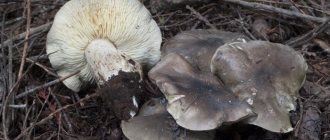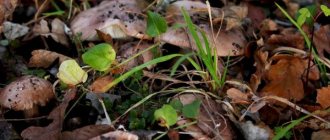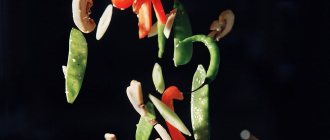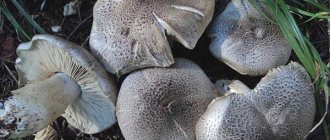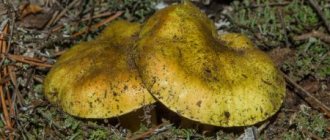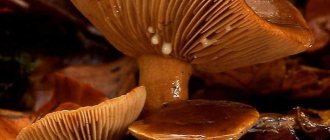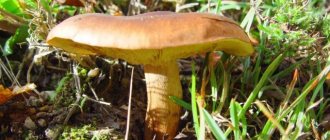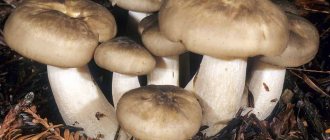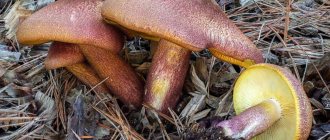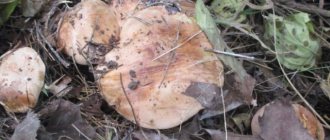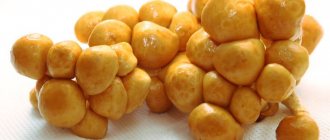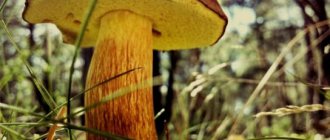Broken row (Tricholoma batschii)
Synonyms:
- Tricholoma fracticum
- Tricholoma subannulatum
Broken rower (Tricholoma batschii) is a mushroom belonging to the Tricholomov family (Ryadovkovy), order Agarikov.
External description
Broken row, like any other varieties of this genus of mushrooms, belongs to the group of lamellar mushrooms, the fruiting body of which consists of a cap and a stalk. Most often, row trees prefer to grow on sandy soils covered with fallen pine needles or moss. The rowers look very appetizing, their fruiting bodies are fleshy and therefore it will not be difficult to spot them in a coniferous forest. The advantage of broken rows is that these mushrooms are not only edible, but also very tasty. They can be eaten in any form. Boiled, fried, stewed, salted and pickled broken rows have an excellent taste and a pleasant mushroom aroma. Interestingly, in addition to its excellent taste properties, broken rows also have healing qualities. The fruiting bodies of this mushroom contain a lot of vitamin B, and therefore extracts from such mushrooms are often used to produce certain types of antibiotics used to prevent tuberculosis and get rid of the tuberculosis bacillus.
The cap of the broken rows is 7-15 cm in diameter, characterized by a semicircular shape in young mushrooms, which gradually transforms into a convex-outstretched shape in mature mushrooms. Often in the central part the cap of the described mushroom is slightly depressed, has an uneven color, and can be brownish-red, chestnut-red or yellowish-chestnut. Its surface is almost always shiny and silky-fibrous to the touch. The edge of the caps of young fruiting bodies is rolled up, but of ripening mushrooms it often cracks and becomes uneven.
The length of the stem of a broken row varies between 5-13 cm, and its diameter is 2-3 cm. The shape of the stem of this mushroom is often cylindrical, very dense and thick, usually narrowing at the base. Its color above the cap ring is white and often has a powdery coating. Under the ring, the color of the stem is the same as that of the mushroom cap. The surface of the stem of the described mushroom is often fibrous, with a flaky coating visible on it. The mushroom pulp is dense, white, and when broken and damaged under the cuticle it acquires a reddish tint. It has a rather unpleasant, mealy smell. The taste is bitter.
The mushroom hymenophore is lamellar. The plates in it are located frequently and are white. In mature mushrooms, spots of a reddish hue can be seen on the surface of the plates. The spore powder is white.
Season and habitat of the mushroom
Broken rows grow mainly in groups, on fertile soils, in pine forests. Active fruiting of the mushroom occurs from late autumn until mid-winter.
Edibility
The mushroom is edible, but must be soaked for a long time before eating. Recommended for consumption only in salted form.
Features of the species and choice of edible mushrooms
In nature, there are more than a hundred species of tricholomas (rows) and only half of them can be eaten. Therefore, before collecting, it is recommended to familiarize yourself with the appearance of edible trichol. Characteristic features that unite most representatives of tricholomas:
| Structure | Peculiarities |
| hat | Covered with scales or fibers, hemispherical in shape (in young specimens). Mature mushrooms have a flat cap. |
| Leg | Fleshy, dense, central. |
| Cover | No |
| Controversy | No color, smooth to the touch |
| Smell | Strong, unpleasant (with rare exceptions) |
| Place of growth | Soil, in mixed and coniferous forests |
| Growth time | August-October |
When choosing edible or conditionally edible tricholomas, you need to pay attention to the color of the cap. Thus, the most popular edible mushroom from the tricholome family, the gray row, has a gray cap with a slight olive or purple tint. The smell of this species is practically undetectable.
Also an edible species is poplar row, a mushroom capable of forming symbiosis with the poplar root system. The cap of this specimen is dense and fleshy, on the surface of which cracks begin to appear as it grows. The color of the hat is quite varied, so you can find both gray-red and olive-brown poplar rows.
In addition to these species, edible tricholomas also include May, purple, crowded, yellow, red, green and earthy row.
False doubles
How to deliciously pickle row mushrooms
Almost all fruiting bodies have twins. The white-brown row is no exception.
| Name | hat | Hymenophore | Danger |
| Lashanka | Brown, chestnut, often cracks, forming scales in the center on the tubercle | Frequent plates attached to the teeth appear red with age | Conditionally edible |
| Row brown | Yellow cap flesh | Yellow or brown | Conditionally edible |
| Sweetie | Surface matte, no mucus, more scaly | The plates are wide, creamy, brown with age | Edible |
| The row is broken | There is a ring under the cap where the white shade of the stem changes to brown; the taste of the mushroom is bitter | The plates are frequent, white, with age reddish spots appear | Edible |
| Topolevka | The cap is light, very fleshy and large | The plates are white or cream, later pinkish-brown | Conditionally edible |
| Speckled row | There are dark spots on the surface, arranged in stripes or circles. Old mushrooms without a tubercle in the center and with an asymmetrical cap; there is no transition of shades on the stem. | The plates are white, later red-brown | Poisonous |
To ensure that no poisonous mushroom gets into the basket, you should be extremely careful when harvesting in the forest. It is better to leave doubtful specimens in place.
Collection rules
Like all mushrooms, broken row, or bitterling, usually grows in coniferous forests. Therefore, there are no special rules for collecting this species. Its fruit body is usually clean and rarely wormy. The only recommendation is not to put broken bittersweet together with other types.
In addition, you should not collect the variety in places close to industrial complexes, highways and landfills. It is also not worth conducting silent hunting in abandoned mines, since substances harmful to health and life remain in the ground for several centuries.
In cooking
Row mushrooms: photos and descriptions, edible and inedible types
This mushroom is very popular in cooking - it is boiled, fried, pickled, salted and stewed. Used for various salads, appetizers, first and second courses.
During cooking, the mushroom aroma and taste intensifies. Goes well with fried onions and potatoes. They add several ingredients to salads - eggs, paprika, sweet pepper, garlic, rice and mayonnaise.
This product is used in dietary nutrition - 100 g contains only 19 kcal. It is often consumed by vegetarians because its chemical composition is similar to meat.
Rows go well with complex carbohydrates - they are served along with durum wheat pasta, rice or buckwheat.
Spices include bay leaf, black pepper, ginger, cloves and coriander.
Considering that mushrooms are capable of accumulating toxic substances, they should be collected away from city parks, highways, and industrial zones.
Mushroom caviar recipe
To prepare caviar from rows, you will need: 170 g of pickled mushrooms, 50 g of vegetable oil, 100 g of onion, salt and pepper (to taste). Finely chop the mushrooms, add chopped onions, fried in vegetable oil. Salt, pepper and mix well. Transfer the caviar to a salad bowl. If desired, garnish with onion rings or chopped green onions.
Video reviews
A selection of videos with descriptions and recipes for preparing mushrooms
Mushrooms BAK - Mushrooms of the LHC, Stervus Lightman, Crimea. Life. Job. Nature
Useful properties of rowing
Row mushrooms: edible and inedible types, description, features, properties of the mushroom of the row family
The composition of the rows is quite diverse. They contain minerals (calcium, potassium, porcelain, in small proportions there is selenium, manganese, copper, sodium, zinc, iron), the entire group of vitamins B, as well as vitamins PP, C, A, D2, K, D7, betaine, choline A huge spectrum in the rows of amino acids - 18 varieties, with a predominance of alanine, phenylalanine, threonine, lysine, aspartic, glutamic and stearic acid. These mushrooms contain the sugary substance “trehalose,” which gives the rows a unique sweetish-fruity taste.
Rowers have a whole range of biologically active substances. They contain clitocin and fomecin - natural antibiotics that have a detrimental effect on various types of pathogenic bacteria and cancer cells. This product contains high levels of phenols, ergosterol and flavonoids, and is found in mushrooms and 10 types of polysaccharides.
Useful and healing properties
Rowers are known for their antibacterial, antiviral, antioxidant, anti-inflammatory, and immunomodulatory properties. With regular use, the activity of the cardiovascular system will improve, heart rhythm will be restored, sugar levels and blood pressure will normalize. Efficiency will also increase, signs of fatigue and nervous tension will disappear, brain activity will be activated, and blood vessels will be strengthened. In addition, the activity of the gastrointestinal tract is toned, the structure of the liver is restored, and the removal of waste and toxins is activated.
Systematic use of rows suppresses the growth of all kinds of cancers and acts to eliminate the progression of negative bacteria. Mushrooms increase resistance to viruses, including influenza, and also suppress the action of the tuberculosis bacillus.
Vitamin B1 in rows is effective against beriberi disease and lowers glucose levels. Based on the purple row, they even developed a nutritional drug to control hypoglycemia.
In addition, violet row has immunomodulatory and anti-inflammatory activity, helps platelet aggregation.
Antidiabetic drugs and various antibiotics are made on the basis of rows. An extract with anticancer activity is prepared from fungal mycelium, which is used to treat cancer (breast cancer, cervical cancer, sarcoma).
In folk medicine, an infusion of rowan grass is used in the form of lotions and ointments for healing skin diseases. An extract from fresh mushrooms is prescribed to neutralize free radicals, cleanse the body, rejuvenate, and improve immunity. Doctors advise including it in the diet for diabetes, hypertension, and nervous system disorders.
Hot extract and powder are effective in lowering cholesterol. It has been proven that gray rower has an even broader effect than a-tocopherol. Violet is considered a good raw material for drugs for diseases of the spleen, liver, genitourinary system, dermatophytosis, rheumatism.
Application
Regardless of the purpose of use, the mushrooms are poured into a bowl filled with warm water. They are washed and cleared of dirt and mucus.
The mushrooms are carefully examined. Rotten, limp, spotted areas are cut out. Wormy fruiting bodies are thrown away whole, even if the lesion is small: there may be parasite eggs in clean areas. After heat treatment they do not die.
Fresh tricholomas are washed as quickly as possible so that the worms do not infect new ones. Washed, peeled specimens are stored in the refrigerator for up to 12 hours at a temperature of 4-6°C. Ignoring this rule leads to loss of nutrients and spoilage of the product due to its biological activity.
In cooking
Ryadovka mushroom is versatile in cooking
Before cooking, pre-heat treatment is carried out for 15 minutes. Next, boil for 30-40 minutes with the addition of onions. The procedure helps get rid of the unpleasant mealy odor and bitterness.
After preliminary preparation, they are fried, salted, marinated, stewed, grilled, and added to first courses. The application is similar to the pine row mushroom. The dried, powdered product is added to sauces to add flavor when preparing meat dishes.
In medicine
Extracts are obtained from the rows. They are actively used to treat liver and kidney diseases. The elements included in the composition help restore liver cells.
Traditional medicine uses dried mushroom powder for ointments and lotions for skin diseases.
White-brown row improves the immune system, speeds up metabolism, which leads to the elimination of cholesterol and toxins. As a result, a person loses weight, systems and organs begin to work without disruption.
Main types of rows
The row family includes more than 2 thousand species, but not all of them grow in Russia. Here are the most common ones:
Violet - edible rows on a dense stem thickened towards the bottom with a flat convex cap, the edges of which are curved inward. The color of this species must have a violet hue.
The pulp of the mushroom is fleshy and dense with a pleasant smell; over time it burns out and becomes light and hollow.
The row is goose or two-color. The mushroom is cream or beige in color, dense with a cap diameter of a maximum of 15 centimeters. Whitish plates under the cap are quite often located.
The giant row or white piglet lives up to its name, that is, a large mushroom with a large massive cap (diameter about 40 centimeters).
The skin is white in color and covered with small scales. The cap is wrapped inside the mushroom in the form of a funnel. The short thick stem is covered with white fibers with a coating in the form of flour.
A special type of mushroom is the May row mushroom or St. George's mushroom. The name is directly related to fruiting immediately after the snow melts in May; they can be found in almost any forest belt.
St. George's mushroom has no competitors, since the bulk of the harvest usually occurs in the autumn season, and its color cannot be ignored.
Preparation
Mushrooms lend themselves well to various processing methods and are used in almost any form: they are boiled, fried, stewed, pickled and salted.
Primary processing and how to soak mushrooms?
To begin with, they are sorted out, cleared of leaves, dirt and grass. After this, wash thoroughly or soak for several hours. Pour clean water into a container, add vinegar and put on fire. After boiling, add washed mushrooms to the liquid and boil for ten
minutes. Then the broth is removed, and the rows are again filled with fresh water and vinegar and boiled for another twenty minutes. In order to remove the mealy smell, add a peeled onion to the container and extend the cooking time for another ten minutes. Then the fruits are placed in a colander.
Cooking
For cooking you will need:
- Take a kilogram of processed mushrooms.
- Pour a liter of water into a pan, add 30 g of salt and a pinch of citric acid. Bring the liquid to a boil.
- Pour the rows into the bowl and cook for 20 minutes. under a closed lid.
- After 10 min. While cooking, throw a couple of clove buds, bay leaves and six black peppercorns into the pan. After 20 min. Place the boiled mushrooms in a colander.
Pickling method
To marinate the rows we will need:
- 1 kilogram of mushrooms;
- vinegar 6% (three tablespoons);
- sugar (one and a half tablespoons)
- black peppercorns (five pieces);
- salt (tbsp);
- bay leaf (two);
- carnation (four inflorescences).
How to marinate:
- Select dense rows.
- Chop large mushrooms (leave small ones as is).
- Pour into a saucepan and cook, skimming.
- Add vinegar.
- Place the mushrooms (without cooling) into sterilized jars and seal.
- Cool the preserved food and store it in a cool place.
Frying
Peel, rinse and place half a kilogram of fresh mushrooms in a deep container. Add 2 liters of water and 30 grams of salt, boil the mixture and simmer for 20 minutes. Place the boiled rows in a colander and let them drain. Then place in a heated frying pan, greased with vegetable oil, and fry for 10 minutes, stirring regularly.
Salting method
Ingredients:
- 1 kilogram of rows;
- 3 cloves of garlic;
- 3 leaves of horseradish;
- several sprigs of dill;
- 10 peppercorns;
- 50 grams of salt.
Preparation:
- Boil the rows, rinse and place in a colander, allowing them to drain and cool.
- Place horseradish leaves in jars.
- Lay out the mushrooms in layers, sprinkling each with salt and garlic.
- Seal the jars.
- The mushrooms will be ready in six weeks. Salted rows are stored in a cool place for up to a year.
Description of the white-brown row.
In youth, the white-brown row has a hemispherical cap with folded edges, then it changes from convex to flat, and a smoothed tubercle remains in the center. The cap is radially fibrous-striped, but this is not always pronounced. The surface of the cap is covered with smooth skin, which can sometimes crack, creating the appearance of scales. The center of the cap cracks the most. In damp weather the cap may become a little slimy.
The cap has smooth edges, but later they can become wavy-curved. The color of the cap is brown-chestnut, brown with a reddish tint. In youth, dark veins are noticeable on the cap, and with age its surface becomes more uniform. The edges are lighter, almost white. Sometimes there are very light specimens.
The pulp is well developed, dense, white, and immediately under the skin it is reddish-brown. The taste of the pulp is not bitter, it does not have a special smell. Under the cap there are frequent plates; they grow to the stem with teeth. The color of the plates is initially white, then small brown-red spots appear on them, which is why they appear reddish. The edges of the plates are often torn. The spores are smooth, colorless, ellipsoidal in shape. The color of the spore powder is white.
The mushroom stalk is cylindrical, often wider at the base when young, and then becomes narrower. Its length is 3-7 centimeters, and its girth reaches 1.5 centimeters. Most often the leg is solid, but in rare cases it is hollow in the lower part. The upper part of the stalk is smooth and the lower part is fibrous. The fibers may be torn and look like scales. The color of the leg can be white, brown, brown, red-brown. At the same time, the transition from color to color can be both sharp and smooth.
Pre-treatment before cooking
Before you start cooking with trichol, you need to clean their surface from pine needles, leaves, soil and sand. You can remove soil and sand using a regular brush, especially paying attention to the surface under the cap. Records tend to get dirty the most. Also, along with the garbage, the remains of the mycelium are removed.
Row processing
After all the debris has been removed, you need to start cleaning with Trichol. Cleaning includes trimming away any damaged or discolored areas and removing the skin covering the cap. After the skin has been removed, it is necessary to thoroughly rinse the product under running water until the water becomes clear.
What rows look like
Row mushrooms grow in forests throughout the temperate zone of our country. All species of this family are autumn, and therefore bear fruit from the first days of September until the end of November. Especially many fruiting bodies appear after the first cold weather, that is, usually in October.
The most common species in Russia are gray, violet, yellow-red and others. Among them there are both very tasty and those that have mediocre taste, although they are quite edible.
All rows, edible and inedible, are lamellar mushrooms with colored (very rarely white) caps of hemispherical and convex shape in young fruits and flat-spread in older ones. Not everyone has a veil; it disappears quickly, sometimes remaining on the leg as a ring. Some species have a floury or strong unpleasant odor. Individual representatives of this family actually grow in long rows (and not in circles or families), which is why this family was given its name.
This family as a whole is very characterized by inconstancy and variability of external characteristics, which significantly complicates their identification in field conditions. For this reason, usually only experienced mushroom pickers go hunting for them. But beginners, even knowing the description well, are sometimes completely unable to figure out which ones are edible and which ones are not.
Time and methods of cooking mushrooms
Before any method of preparing rows, they must be boiled in salted water. Cooking time differs significantly depending on what processing the mushrooms undergo next.
Before frying
Many rows have an unpleasant odor, which can significantly spoil the taste of the dish. Before frying, tricholomas must be boiled for 30 minutes, in two batches.
First of all, you need to bring the water to a boil and only then add the product and salt. For 1 kg of rows, 1/3 tbsp is enough. spoons of salt. Any foam that appears must be removed, otherwise it may spoil the taste of the future dish. Cooking time – 15 minutes.
Beneficial features
Rows have a whole list of useful properties. Thus, it is very valuable for medicine that many antibiotics are obtained from the enzymes contained in the rows, which are most often aimed at combating the tuberculosis bacillus. Mushrooms are also rich in vitamins B, PP, C, A.
These mushrooms are known to help with mental fatigue. Doctors recommend rowing for people suffering from diabetes and hypertension. Due to the fact that mushrooms contain very few calories, they are perfect for dietary nutrition, and the presence of a large amount of microelements and proteins makes them an excellent food for vegetarians. In terms of their chemical composition, they are very close to meat, therefore they can completely replace it.
Edible row mushrooms are very beneficial for humans. Their benefit lies in the fact that mushrooms contain vitamins and substances that have a beneficial effect on the body, helping to cope with many diseases.
Thanks to scientific research and chemical analysis of the fungus, it was found that rowers have these properties
- antibacterial;
- antioxidant;
- immunomodulatory;
- antiviral;
- anti-inflammatory.
In addition, the benefits of row mushrooms are based on the fact that the use of this product contributes to:
- removing toxins from the body;
- normalization of the tone of the stomach and intestines;
- liver cell regeneration.
We can conclude that the described row mushrooms (edible only) should be included in the diet of people with diabetes, oncology, arrhythmia, diseases of the genitourinary system, rheumatism, nervous disorders and osteoporosis.
Chemical composition
The rows contain vitamins B, A, C, D2, D7, K, PP, and betaine. They contain minerals such as phosphorus, iron, sodium, potassium, zinc, manganese. Amino acids - aliphatic, phenylpropionic, hydroxyamino acid, diaminohexanoic, aspartic, aminopentanedioic and octadecanoic acids. They also contain natural antibiotics. These are clitocin and fomecin, they counteract bacteria and cancer cells.
Benefits and harms
The pulp of mushrooms contains a lot of manganese, copper, zinc, and the vitamins riboflavin and thiamine. They also have antibacterial properties, and are good not only boiled or fried, but also pickled.
However, it is not recommended to eat them raw, as they can cause serious gastric upset. Of course, you should avoid poisonous varieties.
The edible gray row, familiar to many, in addition to its positive qualities, also has a number of negative ones. This mushroom tends to accumulate toxic substances and heavy metals if they were collected in areas with polluted air and soil, and overripe specimens are especially dangerous. They do not need to be collected, since if such a mushroom is consumed, it can cause severe poisoning. It can also cause accumulation of gases, a feeling of heaviness and pain in the stomach after consumption.
Answers to common questions
Tricholomas are quite specific mushrooms, many questions may arise before preparing them. Here are the most common ones:
Despite the fact that among the rows there are absolutely edible mushrooms, they cannot be eaten raw, and it is recommended to boil them before any type of processing. Pre-cooking with the addition of salt and vinegar helps get rid of the specific odor of the rows.
| Name: | The row is broken |
| Latin name: | Tricholoma batschii |
| Type: | Edible |
| Synonyms: | Tricholoma fracticum, Tricholoma subannulatum |
| Taxonomy: |
|
Purple row: photo and description
Violet row (Lepista glabra) belongs to the species representing the genus Lepista, family Rowaceae. The mushroom is classified as conditionally edible, which means that it is strictly forbidden to eat it raw.
The most popular edible mushrooms are: chanterelles, porcini mushrooms, russula, honey mushrooms, tremors, rows, moss mushrooms, milk mushrooms, boletus and aspen mushrooms.
Therefore, in order to enjoy the row, it must be thoroughly boiled, and only then subjected to basic culinary processing.
Video: what a purple row looks like
But this does not mean at all that Lepista glabra is a dangerous and poisonous mushroom; it does not contain highly toxic substances, but consuming such a product in its raw form can cause serious stomach upset.
Did you know? The first mention of such a life form as mushrooms occurs in IV BC. e. in the works of the ancient Greek philosopher Aristotle.
In addition, the rower has a rather bright appearance, similar to some poisonous representatives of the mushroom kingdom, so in order for its use not to result in serious consequences, it is necessary to carefully understand the morphological characteristics of the species.
hat
The cap of all representatives of the species can reach a diameter of 6-15 cm. Initially, its color is a distinct purple hue, but over time it changes to pale lilac with a slight manifestation of brown tones.
Often the cap is flat or slightly convex, its edges are not uniform.
Its structure is dense and fleshy, but sometimes it can be watery. The lower part of the cap, bearing the spore-bearing organs, is also a bright purple hue, which fades over time to a grayish-purple color.
We recommend that you familiarize yourself in more detail with the beneficial properties of row mushrooms, as well as their varieties, such as green row mushrooms, poplar row mushrooms and gray row mushrooms.
Pulp
The pulp of the young row is fleshy, dense, almost always elastic, and grayish-purple in color. Over time, it becomes softer, and its shade changes to ocher-cream tones. The mushroom has a characteristic smell; it is predominantly a persistent but pleasant aroma of anise.
Records
The plates are always numerous, thin and wide, attached to the teeth, but in some cases crescent-shaped, almost always free.
They initially have a bright purple hue, which fades over time to a soft light purple color.
Leg
The leg of all representatives of the species is smooth, smooth and fibrous, cylindrical in shape and thickens towards the base. In young mushrooms it is solid, but over time, cavities form in the stem.
Under the cap there is a flaky coating on it. Its color ranges from light purple to slightly pale shades of lilac. The height of the leg can reach from 4 to 8 cm, thickness - no more than 1.5-2.5 cm.
At the base of the stalk, purple pubescence develops - the so-called mycelium.
Spores and spore powder
The spore powder in the row is always light pink or pinkish-yellow.
The spores are small and numerous, slightly rough, ellipsoidal in shape, pink in color. Their length is in the range of 6-8 microns, width no more than 4-5 microns.
Did you know? In nature, there are predator fungi, these are representatives of the genera Arthrobotrys, Dactylaria, Monacroporium, Tridentaria, Trypospormna.
Using mycelium, they create small traps for catching and poisoning small soil worms.
Characteristic features of the variety
All mushrooms have their own unique characteristics. The paths are characterized by a powdery smell and grow in large groups strictly in a row.
Description of mushroom paths
The appearance of the path depends on its type. Mushrooms can reach from 3 to 8 cm in height, have thin (1.5-2 cm) or massive (up to 4 cm) legs. The color of the path can have the following shades:
Usually the flesh of the mushroom is white. As it matures, it acquires a yellowish tint. In some species, the flesh turns pink when cut. Details of the appearance of the path mushrooms can be seen in the photo.
Morphology (species differences)
The fleshy cap is initially hemispherical in shape, but expands as it matures. The edge of the cap is thin, curled, cracked. The surface is most often wet and slippery, but there are types that are dry and velvety. The stem is usually cylindrical, but some varieties have a tuberous shape.
In some species it changes color as it ages. All tracks have records. In some species they are thin and frequent, while in others they are dense and sparse. The pulp is dense. In many varieties, when broken, it emits a pleasant aroma that can be compared to the smell of freshly ground flour or the smell of cucumber.
Place of distribution
Paths are very popular mushrooms. They are common in Europe, Asia, America, and Kazakhstan. In Russia, they are especially common in the regions of Saratov, Volgograd, Omsk, and are also common in the Altai Territory. These regions cannot boast of mushroom abundance, so rowers are consumed here much more than in other places in Russia.
Edible or inedible
Edible paths include the following types:
- black scaly;
- giant;
- pigeon;
- yellow-brown;
- massive;
- blushing;
- poplar;
- grey;
- carved;
- earthy.
The Mongolian and matsutake varieties are considered the most delicious edible mushrooms. Other types of rowing fall into the following categories:
| Conditionally edible species | Inedible species | Poisonous species |
| Silver | White-brown | Sunburnt |
| Golden | Broken | Spotted |
| Shoed | Openkovidny | brindle |
| Greenfinch | Rough | Pointed |
| Scaly | Soapy | Smelly |
| Yellow-red | Dark | Toad |
| Bearded | Separated | White |
| Sulfur | Spruce | |
| Pointed |
Some conditionally edible varieties are used for food after careful processing.
When and how to collect?
Rows can be found not only on the edges of coniferous and deciduous forests, but also in parks and roadside plantings. They skillfully burrow into the soil or hide under leaves and pine needles. Experienced mushroom pickers recommend collecting young mushrooms, because old mushrooms can be toxic. Rowing plants tend to absorb harmful substances from the external environment.
The first mushrooms appear at the end of summer. The main collection continues until October. But some species last until the first frost. Tracks can only be collected in environmentally friendly areas. The rows must be cut with a knife so as not to damage the mycelium.
Because of their habit of hiding, it can be very difficult to find rows. But if at least one copy has been found, the basket is guaranteed to be filled soon. Rowers tend to grow in large families. Myceliums are arranged in rows.
Interesting Facts
Mushroom pickers can very rarely encounter wormy rows in the forest. Their bitter, hot-sharp flesh does not attract these creatures.
Tricholoma alba is a very variable mushroom. It very often disguises itself as edible species, including boletus, champignon, and milk mushrooms.
In the autumn, old fruiting bodies dry out, become stale, and become woody. The leg becomes dry and cracks, which can serve as another characteristic feature that helps to accurately identify this species among others. The brown core is also not a result of worm damage, but natural wear and tear and aging of the fruit.
Some specimens of the row are so tenacious that they can exist without deterioration for 3 weeks.
You need to be able to distinguish white row from other mushrooms so as not to make a fatal mistake and bring home a poisonous one instead of a useful fruiting body. But if poisoning does occur, first aid should be provided immediately so as not to worsen the patient’s condition.
Growing at home
Rowers are one of those mushrooms that are easy to grow yourself at home. The mechanism is reminiscent of growing champignons, but with some caveats.
Place bags with mycelium under trees, in places protected from direct sunlight. Mycelium, as a rule, makes up 0.2% of the substrate weight. It develops best at a temperature of 20 degrees. It is important that the top layer of soil is always moist. In about a month the first harvest will appear. At first, the “baby mice” will appear in waves, and over time they will begin to bear fruit constantly over a period of 3-4 months.
Winter is not scary for these mushrooms. When the air temperature drops below 5 degrees Celsius, the mycelium is covered with straw or a thick layer of leaves. In the spring, when the air warms up to +10, the “insulation” is removed.
But the garden plot is not the only place where you can “settle” a family of rows. They feel great in any room with good air circulation, constant lighting, and at a temperature of 10-15 degrees.
Despite the fact that today the rows have noticeably lost their position in popularity, they continue to remain useful for humans. Moreover, the more researchers learn about these mushrooms, the more beneficial properties are discovered. And even though the “mice” look unattractive in appearance, this does not in any way affect their taste and nutritional characteristics. Well, it’s not for nothing that people once called them one of the most delicious.
Inedible rows
Although most tricholomas are classified as edible or semi-edible, there are also several inedible or even toxic species:
- poisonous - toxic, capable of causing serious food poisoning. The main danger is that it has a fairly good taste and aroma, which is not typical for toxic mushrooms. Recognized by its grayish cap covered with darker scales. The pulp is quite dense, gray near the cap and yellowish closer to the ground.
- white - inedible, toxic, usually having a dull gray color scheme. The white cap is often, although not always, covered with yellow-orange spots. The fleshy pulp is always white. In young fruits it has no smell, in old ones it has a musty smell.
- brown - inedible (according to other sources, conditionally edible), has a bitter aftertaste. Recognizable by its brown cap, covered with small scales, and a noticeable tubercle in the middle. The cap is usually much lighter at the edges. The flesh is pale and dense.
Consumption of poplar mushrooms
Conditionally edible poplar rows cannot be used for cooking immediately after collection. They are pre-soaked for at least a day in cold water. This helps clean young mushrooms from soil particles and remove bitterness.
The water should be no higher than 16°C so that the harvested crop does not ferment. To better remove bitterness and ensure good rinsing, the poplar rows are periodically stirred and the water is changed frequently. Another way to reduce the bitter taste is to remove the skin from the caps.
After soaking for 1-3 days, the poplar rows are boiled and the water is drained. After all the excess water has drained from the boiled mushrooms, the semi-finished product is ready for use.
Poplar rowing is universal. It can be:
- fry;
- cook;
- marinate;
- salt.
Marinated and salted, they are used for making salads and as a snack. Can be used in any recipe with mushrooms.
Signs and first aid for poisoning
The composition of the white row includes a small amount of neurotopic poisonous toxins. Many sources claim that it is impossible to be fatally poisoned by this mushroom. But it is quite possible to get severe poisoning. The first signs of poisoning begin to appear 1-2 hours after eating an inedible mushroom:
- nausea;
- intestinal disorder;
- vomit;
- fainting;
- increased body temperature;
- hallucinations;
- dizziness;
- confusion;
- weakness;
- sweating
First aid for poisoning:
- drinking plenty of water;
- acceptance of absorbents;
- bed rest;
- take a weak solution of potassium permanganate.
Pickled poplars
It’s very easy to marinate floodplains for the winter.
The peeled fruiting bodies should be boiled for about half an hour or blanched for no more than seven minutes, removing the foam. Place boiled or blanched mushrooms in sterilized jars, adding black peppercorns, cloves and bay leaves. To prepare the marinade, add three tablespoons of vinegar, a tablespoon of salt and one and a half tablespoons of sugar for each liter of water. Pour the hot marinade over the mushrooms placed in the jars and roll up the jars. These canned mushrooms can be stored for at least a year. It should be noted that in addition to very good taste characteristics, the substances included in the mushroom pulp help improve appetite, accelerate metabolic processes and lower cholesterol levels. Poplar row pulp can stimulate the gastrointestinal tract, and also contains few calories, so it perfectly complements the menu of vegetarians or people on a diet.
Yellow-brown row: when it grows and how it is used
Yellow-brown row (Tricholoma flavobrunneum) is a capped lamellar mushroom with a cap up to 10 cm in diameter. In young people it is rounded-conical, with age it becomes prostrate, red-brown, darker in the center. The pulp is straw-yellow, bitter in taste.
The plates are frequent, narrow, brownish-yellow, with brown spots in old mushrooms. Spore powder is white.
The leg is up to 10 cm long, thickened at the base, brown or reddish-brown.
It grows in deciduous and birch forests, often forming “witch rings”.
Collection time: August, September.
Used for pickling with other mushrooms.
Definitioner
Basidia (Basidia)
Lat. Basidia. A specialized structure of sexual reproduction in fungi, unique to basidiomycetes. Basidia are terminal (end) elements of hyphae of various shapes and sizes, on which spores develop exogenously (outside).
Basidia vary in structure and method of attachment to hyphae.
Based on the position relative to the axis of the hyphae to which they are attached, three types of basidia are distinguished:
Apical basidia are formed from the terminal cell of the hypha and are located parallel to its axis.
Pleurobasidia are formed from lateral processes and are located perpendicular to the axis of the hypha, which continues to grow and can form new processes with basidia.
Subbasidia are formed from a lateral process turned perpendicular to the hyphal axis, which stops growing after the formation of one basidium.
Based on morphology:
Holobasidia are single-celled basidia, not divided by septa (see Fig. A, D).
Phragmobasidia are divided by transverse or vertical septa, usually into four cells (see Fig. B, C).
By type of development:
The heterobasidium consists of two parts - the hypobasidium and the epibasidium developing from it, with septations (see Fig. C, B) or without them (see Fig. D).
Homobasidia is not divided into hypo- and epibasidia and in all cases is considered to be holobasidium (Fig. A).
The basidium is the site of karyogamy, meiosis, and the formation of basidiospores. Homobasidy, as a rule, is not functionally divided, and meiosis follows karyogamy. However, the basidia can be divided into probasidium, the site of karyogamy, and metabasidium, the site of meiosis. Probasidium is often a resting spore, for example in rust fungi. In such cases, the probasidium germinates into a metabasidium, in which meiosis occurs and on which basidiospores are formed (see Fig. E).
See Karyogamy, Meiosis, Hypha.
Pileipellis
Lat. Pileipellis, skin - a differentiated surface layer of the cap of agaricoid basidiomycetes. The structure of the skin in most cases differs from the inner flesh of the cap and may have a different structure. The structural features of pileipellis are often used as diagnostic characters in descriptions of fungal species.
Based on their structure, they are divided into four main types: cutis, trichoderma, hymeniderma and epithelium.
See Agaricoid fungi, Basidiomycete, Cutis, Trichoderma, Hymeniderma, Epithelium.
Trichoderma (Trichoderma)
The type of cap skin consists of usually straight, septate elements located more or less perpendicular to the surface and laid both at the same and at different levels; the ends of the hyphae can be morphologically modified and represent dermatocystids. The surface of the cap is velvety to almost felt-like.
Lat. Trichoderm.
Trichoderma is further subdivided into Trichoderma intertwined and Trichoderma irregulara.
Intertwined trichoderma (Intricate trichoderm) is a trichoderma consisting of intertwined hyphae located non-parallel to each other and forming a felt pubescence.
Irregular trichoderm is a trichoderma consisting of irregularly branching hyphae.
See Dermatocystida, Hyphae, Septa.
Kutis
The type of cap skin consists of creeping, ungelatinized hyphae located parallel to the surface. The surface of the cap looks smooth.
Lat. Cutis.
See Hypha.
Purple row (Lepista nuda)
Synonyms: naked lepista, titmouse, blueberry.
It is noteworthy that about a month before the start of fruiting, the mycelium of the violet row appears on the surface of the forest litter. So to speak, it carries out reconnaissance in force. At first, the mycelium is almost white, pale bluish, but rather quickly turns into the light purple color characteristic of the fungus itself. Having discovered such purple “cotton wool” enveloping rotten needles and leaves, you can confidently take note of the treasured place and come here during the season for a guaranteed harvest.
Blue mushrooms owe their pleasant fruity, sweetish taste to the sugar trehalose, which is also found in meadow honey mushrooms. Cultivated in a number of countries.
A variety of floodplains
Strictly speaking, there are no varieties of floodplains. There are more than 2,500 species of the family Ordinaceae. Some of them are considered varieties of the same mushroom. The following rows can be taken for undertopolnik:
- crowded;
- gray;
- earthy;
- green;
- brown;
- leopard print
Since these species have a similar growth mechanism (almost underground), they are often mistaken for varieties of floodplains. The fact that the growing places, descriptions and photos of these mushrooms do not coincide with sandpipers is of little concern to anyone. At most, they will be called a false sandpiper/row.
Comment! Podtopolnik is also called the value mushroom.
Most likely for the appearance. But the valui has not the slightest relation to the ordinary ones: it is a family of Russula. The photo shows not one of the types of floodplains, but a valui. He's a bull. It is enough to cut off the fruiting body to understand the difference: the stem of the row is dense, while that of the valuu is hollow.
Signs of poisoning and first aid
When picking mushrooms in the forest, you need to be extremely careful. This especially applies to inexperienced amateurs who may make a mistake and bring home a spotted rower. Eating an inedible mushroom can cause serious harm to your body, especially the digestive system.
Therefore, if such an oversight was made, it is important to quickly recognize the symptoms of poisoning and be able to provide first aid.
The first signs appear quite quickly, within 2–5 hours after consumption. The person begins to feel discomfort in the body and general malaise
It is important to remember that symptoms can increase very quickly. Therefore, you need to immediately call an ambulance
Main signs of poisoning:
- nausea;
- cutting pain in the abdomen;
- profuse vomiting;
- diarrhea;
- loss of orientation in space;
- severe decrease in pressure;
- disruptions in the functioning of the cardiovascular system;
- sweating;
- general weakness;
- dizziness.
- Rinse the patient's stomach. To do this, you need to drink as much water as possible. Next, touch the tip of your tongue with two fingers and artificially induce a gag reflex. The procedure is unpleasant, but it is necessary - in this way all dangerous substances are removed from the body and intoxication is significantly reduced. The poison stops being absorbed into the walls of the stomach and enters the blood.
- Give the victim sorbents to drink. For example, activated carbon, which it is advisable to always have in your first aid kit.
- The patient needs to drink a lot of clean water.
Performing these actions will significantly alleviate the condition and reduce the harm caused to the body by the inedible mushroom. If everything is done in a timely manner, the person recovers completely and the symptoms of poisoning disappear without a trace.
Possible harm from the mushroom
Row mushrooms accumulate wastes that come from the atmosphere, as well as heavy metals. In view of this, overripe mushrooms that grow along highways and near large cities will most likely not be useful, but rather harm the body. If you overeat, there may be excessive accumulation of gases in the intestines, pain and heaviness in the abdomen. It is harmful to overeat mushrooms for people with low acidity, inflammation of the stomach walls, contractility disorder and inflammation of the gallbladder and pancreas.
If you feel unwell after eating mushrooms, call a doctor immediately.
Brown row - when used correctly, can have a positive effect on body functions. Its healing properties have long been proven and tested. The mushroom is successfully used both as a medicinal remedy and in cooking. Despite its bitter taste, rows are an ingredient in many recipes. But do not forget about the dangers and restrictions associated with the use of these mushrooms.
Sources:
https://fermoved.ru/gribyi/ryadovka-belokorichnevaya.html https://edaplus.info/produce/blewits.html https://fermer.blog/bok/griby/uslovno-sedobnye-griby/ryadovka/vidy- ryadovki/13242-rjadovka-korichnevaja.html
Signs of poisoning and first aid
White rowers are not eaten because of their pungent odor and the burning, acrid taste of the pulp. In some sources, this mushroom is considered poisonous, although it is believed that it is almost impossible to be fatally poisoned by it.
Tricholoma alba contains small amounts with neurotropic and local irritating effects. Symptoms of poisoning: dizziness, nausea, vomiting, mild hallucinations, intestinal and stomach upset.
First aid for poisoning:
- Call a doctor or ambulance immediately.
- Provide the patient with plenty of fluids and bed rest.
- Take activated carbon and other drugs with similar effects.
- Rinse the stomach with a weak solution of potassium permanganate.
If you provide timely and qualified assistance, the symptoms of intoxication quickly disappear without serious consequences.
Ecology and distribution:
The period of growth of floodplains is from mid-August to early October. The main difference between the mushroom and others is its aroma. Podtopolniki have a pleasant aroma of fresh flour. Thanks to this wonderful smell, podtopolniks are especially tasty when pickled or salted. It is better to pick mushrooms when they are young, when the mushroom cap has not yet opened. During this period, the flesh of the mushroom is hard and practically not susceptible to worms.
Poplar rows are common wherever poplars grow - these are the territories of North America and Canada, Western and Eastern Europe, Central Asia, as well as central and southern Russia, the Urals, Siberia and the Far East. Its main growth period begins during the autumn leaf fall season, around the end of August, and ends at the end of October.
